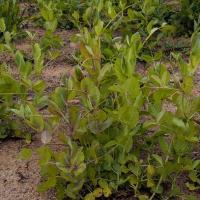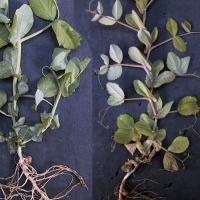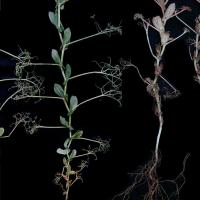Diagnosing nodule dysfunction in field peas
Nitrogen deficiency from nodule dysfunction can be caused by lack of Rhizobia, soil conditions, herbicide toxicity, or molybdenum or sulphur deficiency.
What to look for
- Smaller paler plants, with severity often varying with soil type.
- Plants may recover slightly in spring.
Paddock
- Symptoms may appear within a month of seeding.
- Nodules are reduced or absent.
- Intially the plants are smaller and paler with a pink shade. Symptom severity often varies according to available soil nitrogen.
- Older growth is first and worst affected old leaves becoming yellow-mottled to marginally chlorotic.
- As deficiency worsens plants becomes stunted and pale; older leaves become progressively pinkish pale and die, leaving green new growth.
- If nodules are present they are small, and when split have pale or white, rather than pink interiors.
Plant
What else could it be
| Condition | Similarities | Differences |
|---|---|---|
| Diagnosing waterlogging in narrow-leafed lupins and field peas | One cause of nodulation failure | Causes premature plant death if sustained |
| Diagnosing potassium deficiency in field peas | Smaller pale plants | Nodules present |
Where did it come from?
- Lack of suitable rhizobia. Group E rhizobia used for field peas persists poorly in acidic soils . Nodules will be absent.
- Residual herbicides can prune fine roots and reduce nodulation.
- Cold or wet conditions inhibit nodulation formation and function, but plants generally recover when in warm well-drained conditions.
- Molybdenum deficient plants also have white or green nodules, but deficiency is most likely in acidic soils.
- Sulphur is also required for effective nodulation, but severe deficiency is only likely on deep sandy soils that are not suitable for field peas.
- High soil nitrogen levels can inhibit nodulation.
Management strategies

Top dressing
- Pea crops should be inoculated with Group E inoculum on neutral to acidic soils.
- Symptoms on severely affected crops may be alleviated by applying inoculum to the soil surface in wet rainy conditions.
- Nitrogen fertiliser also alleviates symptoms.
How can it be monitored?

Tissue test
- Check roots for nodules with a pink interior.
- There is no reliable soil test for molybdenum or cobalt deficiency.
- Use youngest fully-emerged leaf to test for molybdenum. Levels less than 0.005mg/kg indicate deficiency. Take paired good/poor plant samples when possible.
See also
Further information
Where to go for expert help
Page last updated: Wednesday, 13 May 2015 - 3:51pm




